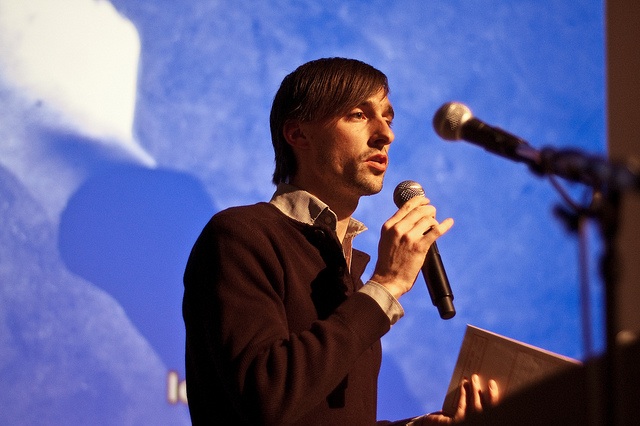
Maarten Brinkerink, organizer of the "Remixing and Re-Use of Open Video Collections" Workshop. Photo by Anne Helmond.
Just a day before the much awaited sixth edition of Video Vortex, students, media producers, video amateurs and overall new media enthusiasts are gathering in the Netherlands Media Art Institute to indulge their geeky tendencies in some open video remixing and experimenting.
In the context of the Open Images project, participants of this workshop will get creative with material from the Netherlands’ public broadcasting archive, to make their own short videos. We’ve now just started and this is the goal of the day: each and everyone of the participants needs to make a short (1 minute) movie by the end of the day.
But first things first. Who is responsible for all this?
The workshop is organized by Maarten Brinkerink project manager of the Netherlands Institute for Sound and Vision and it is lead by mixed media artists and Emile Zile and José Miguel Biscaya.
And so, amidst the tangle of ethernet cables providing the much needed internet connection, the workshop begins.
As we present each other it becomes clears that a lot of participants have some experience with video editing but no experience whatsoever with open source video. To which Emile clarifies that there’s quite a difference between video editing experience and experience working with samples and remixing.
José describes what we’ll do today as making a college, something that most likely everyone is familiar with even if only from his/her kindergarden days. He explains that sampling is about taking something out of its context and doing something else with it, more than experience what you really need is intuition. So its not about building tight narratives but rather interesting mash-ups. Keeping this in mind Emil and José gave a series of tips that I summarize here.
- Think about audio, it can really change the meaning and add a new layer to your remixed video – As an example Emile mentions the Gendered Advertiser Remixer a tool where one finds two columns, one with video material and one with audio material from commercial ads and can then combine then. Consequently, one comes up with very uncanny ads where Barbie is showing off her silky smooth blond locks to a narrator with a deep bass voice more apt for a G.I.Joe add. This kind of wacky gender bias experimentation works because the duration of both audio and video material is the same, both sample banks are 30 seconds long. Furthermore, they both have quick video editing and quick paced dialogue. So these unexpected collisions between different media end up producing a “third meaning.”
- Get a broad range of samples to work with – that is, even if you have an idea in mind, say kittens for a new addition to the ever growing LOLcats collection, don’t stick to samples only from that area. When you are doing your search look for material in other topics like say, religion, you never know what you made find.
- Chance is on your side – Think about chance collisions. This is one area where randomness can be a good thing.
- Forget the Timeline – “Timelining” or making a structure doesn’t really work for this kind of endeavor. It is more about seeing what collisions and connections work.
- Get rhythm – You don’t need to make a film that looks like a film with a beginning an end, you can go by rhythm. For example cut a series of left to right motions and mash them together.
I’ll be tuning in again later to let you know all about the specific sources to find material and resources to edit them in order to create your own video stories with found material, as promised by the Video Vortex organizers.


